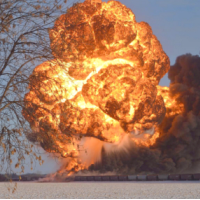Report Maps Oil-Train Paths Across Socially Vulnerable Urban Areas
 Crash of two trains, one carrying Bakken crude oil, on Dec. 30, 2013, in North Dakota. (photo: U.S. Pipeline and Hazardous Materials Safety Administration)
Crash of two trains, one carrying Bakken crude oil, on Dec. 30, 2013, in North Dakota. (photo: U.S. Pipeline and Hazardous Materials Safety Administration)
When oil prices were near their peak a year ago, rail shipments of crude from the newly-fracked fields of North Dakota and elsewhere surged in California. The promise of this new, convenient source of business for refineries and export lie in the fact that train delivery was still only 1% of the state’s oil traffic.
The 506% increase in California oil rail imports in 2013 happened without much public knowledge and even less input. Every once in a while the trains would be hard to ignore, like July 2013 in Lac-Mégantic, Quebec, when 63 tank cars of crude oil exploded, killing 47 people.
As impacted municipalities scrambled to see what, if anything, they could do about an area of transportation overseen by the federal government, world events led to a significant decline in the price of crude and shipments from western states dropped.
But oil and rail companies are poised to ramp up their efforts, and a new report (pdf) says when they do residents already deprived of environmental justice—people of color, low-income and poor English skills—will bear the brunt of it.
ForestEthics and Communities for a Better Environment (CBE), a couple of nonprofit groups, found that “while 60% of Californians live in environmental justice communities . . . 80% of the 5.5 million Californians with homes in the blast zone live” in them. About 75% of those in the blast zone are Hispanic-Latino, African-American or Asian. Twenty-two percent of the residents within the blast zone are white, compared to 45% outside the zone.
“It’s simple,” according to CBE Northern California Program Director Nile Malloy. “Oil trains contribute to environmental racism in California. Environmental justice communities like Richmond and Wilmington that already live with the highest risk are hardest hit.”
The blast zone is the one-mile evacuation area astride the rail path recommended by the U.S. Department of Transportation (DOT) in case of an oil train derailment and fire. The researchers looked at the 10 largest California cities with current and probable oil rail routes and used U.S. Census Bureau data. The report maps the blast zones for the cities plus four urban areas where CBE does work.
The trains pose a larger threat than just explosion. They leak oil and vapors into the ground and air. Idling trains and idled vehicles at crossings foul the air with diesel particulates. Noise is worse. Refineries may end up burning dirtier crude.
California oil train shipments were down 44% in January and February, according to Reuters. But oil companies do not appear deterred. They are reportedly proposing to build 15 more offloading stations in the state and government officials said California’s reliance on rail crude could increase from 1% to 25%.
Last year, the Natural Resources Defense Council (NRDC) released seven maps detailing the rail routes through the “Crude Oil Train Derailment Risk Zones in California.” They stretch from the Bay Area to the Central/San Joaquin Valley and encompass 4 million people.
That report called the trains “soda cans on wheels” and recommended removal of old tanker cars from service, lower speeds for trains, rerouting through less-sensitive areas, disclosure of what kind of crude is being carried, more visible emergency preparedness, fees on shippers to pay for emergency response, high-risk designations for oil-trains and more comprehensive risk assessments.
So far, that’s not happening and the plight of those already most burdened in California isn’t likely to spur great change. It could take a catastrophic blast or a derailment close to people who actually have some power.
The blast zone crosses the State Capital in Sacramento.
–Ken Broder
To Learn More:
California Oil Train Risks Worse in Minority Areas: Report (by Terry Wade, Reuters)
Report Calls out Environmental Racism (Communities for a Better Environment)
California Crude by Rail Imports Fall Sharply in Feb -Gov't (by Rory Carroll, Reuters)
This Is Where Deadly Crude Oil Trains May Be Rolling Through California (by Ken Broder, AllGov California)
Crude Injustice on the Rails (Communities for a Better Environment and ForestEthics) (pdf)
- Top Stories
- Controversies
- Where is the Money Going?
- California and the Nation
- Appointments and Resignations
- Unusual News
- Latest News
- California Forbids U.S. Immigration Agents from Pretending to be Police
- California Lawmakers Urged to Strip “Self-Dealing” Tax Board of Its Duties
- Big Oil’s Grip on California
- Santa Cruz Police See Homeland Security Betrayal in Use of Gang Roundup as Cover for Immigration Raid
- Oil Companies Face Deadline to Stop Polluting California Groundwater





